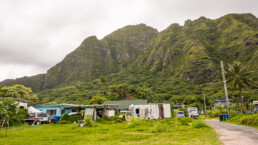The U.S. Army Corps of Engineers, which is leading the remediation effort, has been plagued by shoddy work and multiple regulatory disputes, according to an investigation by the Honolulu Star-Advertiser and ProPublica.
by Rob Perez, ProPublica and the Honolulu Star-Advertiser
For the better part of two years, Liliu Ross had lived in a one-room tin-roofed shack in the rural outer reaches of Hawaii’s Big Island. It had no running water and no electricity. But it provided shelter for Ross as she raised sheep and grew crops on land that her Native Hawaiian ancestors once called home. From the open fields and gentle slopes of her five-acre farm lot, she marveled at the stunning views of nearby Mauna Kea, one of the world’s tallest island mountains. Still, there were challenges to living under such conditions. At night she read by candlelight, and during the day she bathed outside with water she warmed in a pot over a fire.
So, in 2014, Ross secured a loan under a special program funded by the U.S. Department of Housing and Urban Development to help Native Hawaiians build or purchase homes on Native lands. An architect created drawings for a two-bedroom, one-bathroom house, complete with energy-efficient appliances and a covered lanai. And she even picked the location for the new home.

Within months, though, her plan collapsed. Ross learned in a phone call from her builder that HUD had imposed a freeze on federal housing funds throughout the region. As it turned out, her property had been part of the Waikoloa Maneuver Area, a 185,000-acre site that was used by the U.S. military for live-fire training in the 1940s. Troops had fired an unknown number of grenades, mortars and other munitions that failed to explode, and many of the potentially deadly weapons remained, hidden beneath years of soil and vegetation buildup. Federal authorities wanted to ensure the land was safe to use.
Recent Posts
‘Unconstitutional. Unethical. Authoritarian.’ ICE Bars Millions Of Immigrants From Bond Hearings
July 18, 2025
Take Action Now One watchdog said the new policy “seems like a blatant attempt to stop them from exercising their right to due process.”……
Americans Are Not Nearly Alarmed Enough About Climate Change
July 18, 2025
Take Action Now Americans still don’t comprehend how imminent, dangerous, and far-reaching the threat is—and journalists are partly to blame.By…
The IRS Is Building A Vast System To Share Millions Of Taxpayers’ Data With ICE
July 17, 2025
Take Action Now ProPublica has obtained the blueprint for the Trump administration’s unprecedented plan to turn over IRS records to Homeland Security…
Israel’s Sudden Assault On Syria Is Unchecked Aggression
July 17, 2025
Take Action Now Jerusalem is bombing Damascus and threatening al-Sharaa’s rule, while Washington was hoping to help the nascent government on…




